We have all been in a situation where a certain bug entirely ruined our app user experience. But why do things like that happen? The answer is quite simple: the lack of web application testing.
The testing phase is an incredibly important part of app development yet some developers underestimate it. The problem is that the chance of a bug appearing increases with every life of code and the costs of bug fixing rise with time.
However, with proper website testing, none of that has to happen. So if the application testing runs smoothly, the app is ready to be released. It’s as simple as that.
If the development is done with Agile principles applied, it’s important to “mix” the testing phase with the development phase properly.
Web Testing: Basic Steps
If you want to make the app right, you need to go through 6 basic steps of the testing phase. Let’s take a look at every one of them!
Step 1: Functionality Testing
What is a web application? Let’s assume you already know the basics and let’s get straight to the point.
The first step of the testing phase is to make sure that the web application is functionally correct. Functionality testing checks the database connection, all links in the web pages, cookies, forms used for submitting and/or getting info from the user etc.
It should be done early in the developing stages to speed up the whole app-building process and it reduces risks toward the end of the cycle. It boils down to performing a set of tasks that can be performed both automatically with the use of a software program or manually with a human tester.
Once you get the results of those tasks, you simply compare them with the expected output. It has to be done multiple times with different data input. If the level of accuracy is the same every time, the app is considered functionally correct.
Of course, no one is expecting every single little bug to be fixed every time, but testing websites frequently gives us a better chance to develop apps that are as functional as possible.
Step 2: Usability Testing
When thinking about how to test a website, the second step should be usability testing. This type of testing combines the previously mentioned functionality testing with the overall user experience.
It is not the same thing as User Acceptance testing since the focuses are entirely different and so are the stages of the app development during which these tests are performed.
Usability testing can be done by getting external testers that simulate your expected user base, or internally by the developers themselves. If you want to perform external testing but don’t know where to find suitable testers, apps like Apple’s TestFlight might help you.
Usability testing can be broken down to 4 stages:
- Developing the testing strategy in a way that all functions of the app are examined including the navigation and content
- Recruiting the internal or external test participants
- Running the test with the team of experts
- Analyzing results and improving your app accordingly
This video course gives a few great approaches to usability testing in less than an hour.
Step 3: Interface Testing
This web page test checks whether or not all interactions between the app server and the web server run smoothly. Not only the communication process needs to be tested, but the displaying of error messages as well. Also, this test is used to determine whether the interruptions by the server and/or by the user are handled properly.
Step 4: Compatibility Testing
In the era of portable devices and all kinds of screens, compatibility testing is important to ensure that your web app displays as it should on all device types.
The developers need to run the browser compatibility test to check if the app is displayed correctly in different browsers. Another test to run is the mobile browser compatibility which, as the name suggests, is supposed to confirm that the app displays correctly across mobile browsers.
Different operating systems display certain app elements differently. This is why it is important to run the compatibility tests with as many operating systems as possible, especially the most popular ones such as Windows, Mac, Linux, as well as with different popular browsers such as Chrome, Internet Explorer, Safari, Firefox etc.
Step 5: Performance Testing
Once you know your app is functional and responsive, you need to check its performance under a heavy load. Performance testing includes testing under different internet speeds as well as under normal and peak loads.
Even in a wider context it might be a good idea to test your overall web server performance on a basic level, through a website speed automated test, as page speed influences user experience a lot, and affects your public website’s SEO. Focus on optimizing your website for mobile devices as mobile SEO plays a vital role in generating quality traffic from search results. This article gives a good insight into how a basic speed test can be performed with free tools, and how to use the data for preparing an optimization plan. It’s not actually a proper in-depth performance and stress testing, but a good starting point.
Stress testing is useful to determine the breaking point of the app; it involves putting the app under increasing amounts of stress until it stops functioning. After all, you need to discover your app’s breaking point before the users do.
[activecampaign form=25]
Also, keep in mind that you need to determine how your app recovers from crashes. If the recovery isn’t smooth, you need to work on its improvement.
Step 6: Security Testing
Once the web application is developed, it has to be tested for security. This type of testing includes all kinds of processes to determine the app’s weak points and improve them as much as possible.
Normally, a serious of fabricated malicious attacks are used to test how the app responds and performs under these circumstances. If security shortfalls are detected, it is important to find the best way possible to overcome them.
Here are the basic steps of security testing:
- Understanding the security goals and planning the test by considering the security needs of each of them
- Identifying the app’s security needs
- Gathering the info about the elements used to develop the app including the OS, hardware, technology etc.
- Identifying and listing all potential threats and vulnerabilities
- Preparing the threat profile based on the listed vulnerabilities and risks
- Preparing the test plan
- Automated testing on top of the manual testing
- Preparing the Security tests case document
- Carrying out the Security test cases execution, fixing identified defects, retesting
- Creating a detailed report on the security testing, including the solved issues and the risks that still persist
Here’s a great course explaining all basics (and beyond) of Ethical Hacking and Penetration Testing for web apps.
Best Web Application Testing Tools
How to test a website? Easily. All you have to do is find the right web application testing tools. Let’s take a look at some of them designed specifically for web-based testing.
Zephyr

Zephyr is currently the most popular web application testing tool – and for all the right reasons. Here are its key features:
- 1 click integration with JIRA, Confluence, Jenkins, Bamboo, and more
- Cloud, Server, and Data Center Deployment Options
- Advanced Analytics and DevOps Dashboards
- No Annual Commitment Required
TestLink
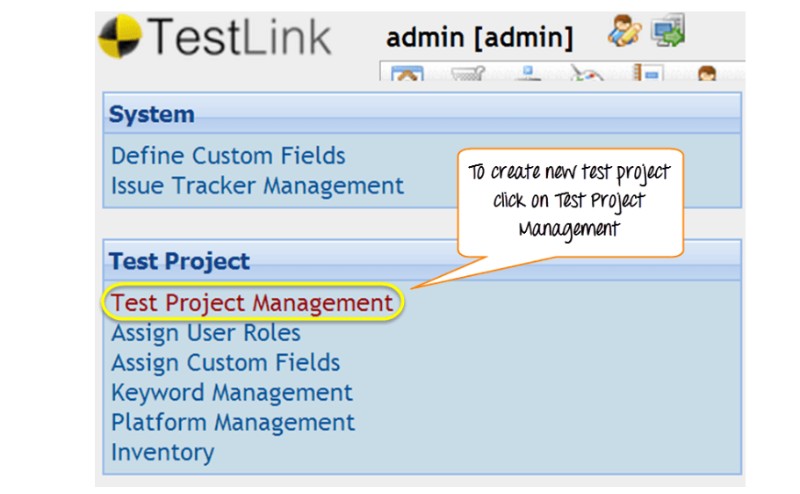
TestLink is an open source tool that will help you manage your website testing in the easiest way possible. It comes with a bunch of useful options and features including:
- Charts Support
- Metrics Support
- Test creation and execution
- User-friendly UI
- Defect Recording
PractiTest

PractiTest is a great tool for web-based application testing and development. It allows you to:
- Create your manual tests and organize them based on cycles, sprints, etc.
- Seamlessly integrate your manual testing with your automation and CI processes; other integrations include but are not limited to: JIRA, Pivotal Tracker, YouTrack, FogBugz, Bugzilla, Redmine, GitHub, Selenium, JUnit, SoapUI, QTP, Jenkins, Circle CI, and Slack
- Reuse tests and correlate results across different releases and products
- Release your products with confidence and control
TestComplete
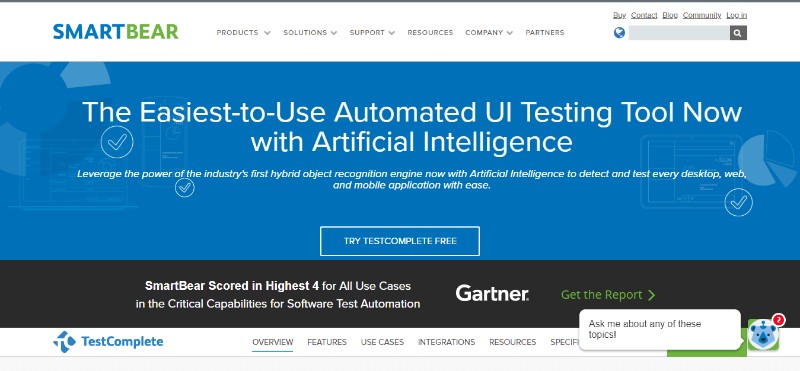
TestComplete is an easy-to-use UI testing tool with artificial intelligence. It supports a variety of scripting languages as well as various testing techniques.
With TestComplete, you can:
- Test every application using object recognition with AI
- Build and maintain automated GUI tests easily
- You can choose to script or not to script with the flexible test automation
- Reuse your functional tests
- Use an automation tool built for continuous testing
- Take advantage of the great customer support
Other useful features include:
- Support for 7 different scripting languages
- The ability to record robust automated tests without scripting knowledge
- Industry-leading object recognition
- Comprehensive defect tracking and reporting capabilities
Selenium
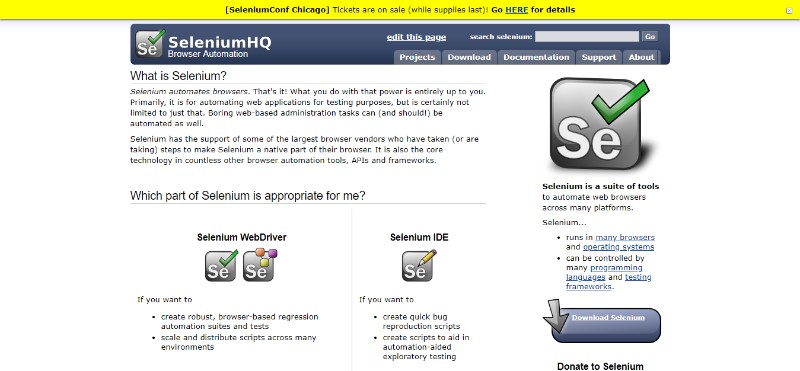
Selenium is an open-source tool for web app testing and currently, it is one of the most popular online software testing tools out there.
It can automate across multiple OS including Mac, Windows, and Linux, as well as the most popular browsers, such as Chrome, Firefox, IE, Headless Browsers etc. It supports various programming languages for test scripts including Java, Python, C#, Ruby, JavaScript, PHP, and Perl.
HP UFT (aka QTP)
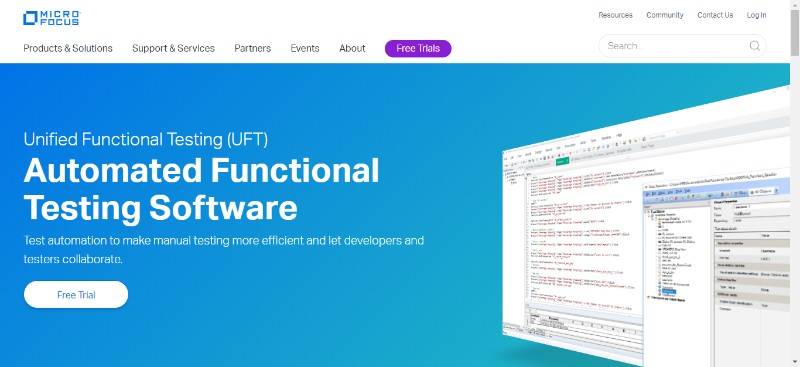
If you aren’t sure how to test web application, HP UFT/QTP might be just the thing you are looking for.
This useful tool can automate all kinds of applications, including but not limited to: Web, Desktop, SAP, Delphi, Net, ActiveX, Flex, Java, Oracle, Mobile, PeopleSoft, PowerBuilder, Siebel, Stingray, Visual Basic etc.
Here are some of the key features of this system:
- Broad technology support
- Continuous testing
- 1-click manual to automation
- API and web services testing
- UFT Mobile
- Keyword or script-based testing
- Designed for collaboration
You can choose between two different solutions: Unified Functional Testing (UFT) and Lean FT.
Some of the additional features that Lean FT comes with include:
- Develop tests in Visual Studio using C#
- Develop tests in Eclipse using Java
- Source Control / Version Control Tools
- Open Source TDD & BDD Framework Integration
Tricentis
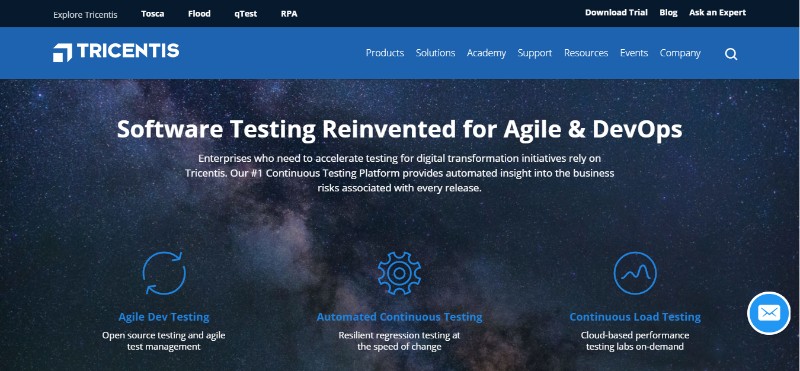
Tricentis is one solution that supports over 150 different technologies to help you plan, construct, stabilize, and execute resilient end-to-end tests.
It supports 3 test types:
- Agile dev testing
- Automated continuous testing
- Distributed load testing
Its capabilities include:
- Predictive analytics
- Agile test management
- Service virtualization
- Risk-based design
- Reporting
- Test data management
- Cloud provisioning
It supports all kinds of protocols, including but not limited to HTTP(s) JMS, AMQP, Rabbit MQ, TIBCO EMS, SOAP, REST, IBM MQ, NET TCP etc.
BugZilla
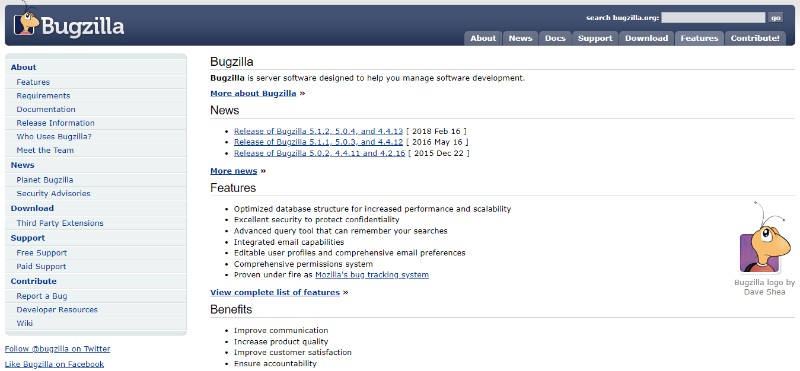
Just like the name suggests, Bugzilla will help you detect if there are any bugs hidden in your apps. In addition to that, it comes with all kinds of useful features including:
- Optimized database structure for increased performance and scalability
- Excellent security to protect the confidentiality
- Advanced query tool that can remember your searches
- Integrated email capabilities
- Editable user profiles and comprehensive email preferences
- Comprehensive permissions system
- Proven under fire as Mozilla’s bug tracking system
And here are some of the benefits:
- Improve communication
- Increase product quality
- Improve customer satisfaction
- Ensure accountability
- Increase productivity
- Bugzilla can adapt to multiple situations
Sauce Labs
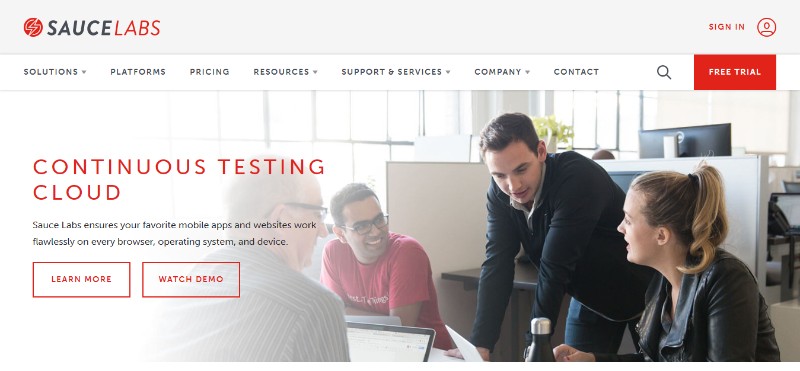
Sauce Labs is a continuous testing cloud ensuring that the mobile apps work flawlessly on all devices, operating systems, and browsers.
The key features include:
- Automated web testing
- Mobile app testing
- Continuous testing experts
- Comprehensive coverage
- Enterprise security and scalability
Sauce Labs offers 4 different subscription plans so you can check out all the included features and choose the plan that best fits your needs and budget.
LoadUI Pro
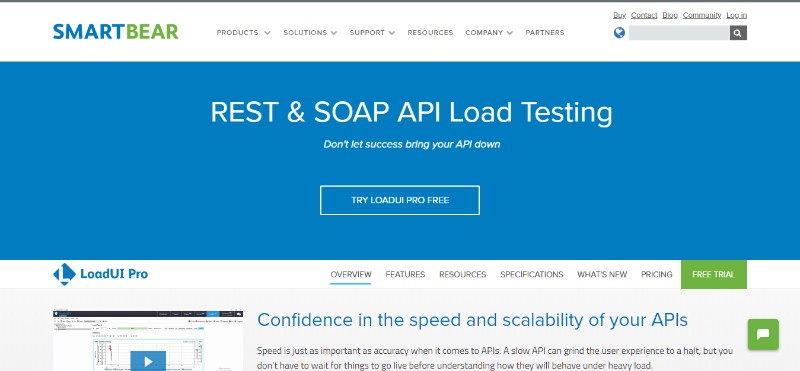
LoadUI Pro by Smartbear is a great tool for creating load tests and get detailed reports of the rest results. Here is how it works:
Rapidly create API load tests
- Test the speed and scalability of new changes to your APIs in minutes
- Preview API performance behaviors before releasing to production environments
- Shift performance insights more to the left so developers build more reliable code
Gain insight from real-time API load tests
- Throw multiple varying loads of traffic at your API simultaneously
- Record traffic from mobile devices and replay at large volume
- Visualize the effects of a load test on your server and network resources
Simulate traffic from the cloud or on-premise
- Scale any load test you build out indefinitely
- Generate load from Windows or Linux-based nodes
- Send a mix of either on-premise or off-premise traffic
Visualize the impact of load on your servers
- Operating Systems: Linux and Windows performance collections
- Web Services: IIS, Apache, Tomcat, WebLogic
- Databases: MS-SQL and MySQL performance
Perform comprehensive API load testing
- Save time by re-using API functional tests as load testing workload
- Use dynamic data in your API load tests for more realistic simulations
- Virtualize external APIs that don’t allow or handle load tests very well
- Overcome 3rd party rate limits and overage charges during a load test
Case Complete
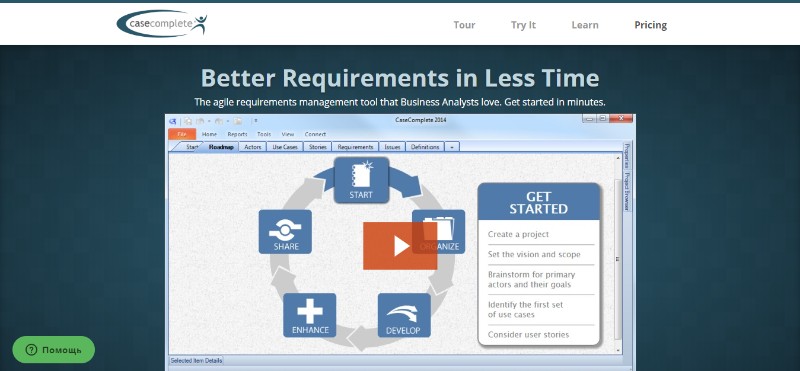
Case Complete is a useful tool for:
- Storing Requirements
- Identifying undefined, missing, or to be defined requirements
- Traceability of Requirements
- Interfacing with Test Management Tools
- Requirements Coverage
FAQs about web application testing
1. What is web application testing, and why is it important?
Testing web-based apps to make sure they function properly and satisfy user expectations is known as web application testing.
It is crucial because online apps are often utilized and might have negative effects, such as data loss or security breaches if they malfunction.
2. What are some of the different types of web application testing, and how are they different?
Functional testing, performance testing, security testing, usability testing, compatibility testing, and other sorts of testing are among the several types of web application testing.
Non-functional testing concentrates on other elements including performance, usability, and security, whereas functional testing concentrates on the functional needs of the application.
3. What is the difference between functional and non-functional testing?
Non-functional testing examines the application’s performance, security, and usability, while functional testing determines whether it is operating as intended in accordance with its specifications.
In order to make sure the program is dependable and meets user expectations, both kinds of testing are crucial.
4. What is test automation, and why is it useful in web application testing?
Using software tools to automate the testing process is known as test automation. It is helpful in web application testing since it can speed up the process, lower the risk of errors, increase test coverage, and make testing more regular.
5. What is regression testing, and why is it important in web application testing?
Regression testing is retesting the application following changes to make sure that no unforeseen effects take place.
Regression testing is crucial to web application testing since it helps to identify issues before they affect users and are brought on by modifications to the application.
6. What is the difference between unit testing and integration testing in the context of web applications?
While integration testing examines how well the various pieces of code interact, unit testing is more focused on the individual pieces of code.
Unit testing can be used to test specific functions in the context of web applications, whereas integration testing can be used to test the interactions between various application components.
7. What is load testing, and why is it important in web application testing?
Testing an application under significant loads to see if it can support the anticipated number of users is known as load testing.
Load testing is crucial for web application testing since it helps to find and fix performance issues before they have an impact on users. High traffic might result in performance concerns.
8. How do you test for security vulnerabilities in web applications?
Application vulnerabilities and flaws that could be used by attackers are tested during security testing.
Web applications are a frequent target for attacks and can have major repercussions if they are hacked, hence it is crucial in web application testing.
9. What are some of the challenges of testing web applications, and how can they be addressed?
The complexity of web applications, the requirement for frequent updates, and the requirement to test across various platforms and devices are some of the difficulties in testing web applications.
Test automation, continuous testing, and the use of testing best practices can all be used to overcome these difficulties.
10. How can you ensure that web application testing is comprehensive and effective?
Understanding the requirements and user expectations of the program is crucial to ensuring that web application testing is thorough and successful.
All facets of the program should be covered by the test cases, and testing should be carried out on many platforms and gadgets. Continuous testing and test automation can also help to guarantee thorough and efficient testing.
Ending thoughts on web application testing
What is web application testing? In this article, we explained the importance of this part of app development as well as the necessary steps you need to take to test your application properly.
Frequent web application testing minimizes the chance of bugs ruining the customer experience and it also gives you a better overall idea about how your app performs, what its strengths are, and where the weak points are hidden. All of these web application testing software are in line with the latest web development trends and technologies.
If you enjoyed reading this article on web application testing, you should check out this one about web application development.
We also wrote about a few related subjects like web technologies and web development trends.
- Web Technologies Every Web Developer Must Know - April 17, 2024
- Web Application Testing: Step by Step Process to make it Right - March 22, 2023
- Web Application Development: Resources, Best Practices, and How to do it - March 12, 2023









